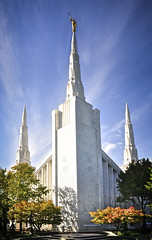The professor was quoted in the local newspaper today because of a rather brilliant paper he wrote last year. Check it out.
New highway safety report says Oregon roads safer than ever
Published: Thursday, September 09, 2010, 8:44 PM Updated: Friday, September 10, 2010, 9:25 AM
The rate of traffic deaths on Oregon roads reached its lowest point in history last year, spurred by high seat-belt use, aggressive enforcement of drunk-driving laws and the recession.Oregon's traffic deaths plummeted 9.4 percent from 416 in 2008 to 377 in 2009, according to new report from theNational Highway Traffic Safety Administration. Washington's road fatalities dropped from 521 to 492, a 5.6 percent decline.
Although Americans drove slightly more than in 2008, traffic deaths fell 9.7 percent nationally to 33,808 – the lowest number since 1950. In 2008, an estimated 37,423 people died on the highways.
Certainly, Oregonians appear to be on the road to an even safer 2010.
As of Tuesday, following a Labor Day weekend that saw only one fatality, there were 210 reported traffic deaths this year. That's a 16 percent decline from the same period in 2009, when 249 had been recorded.
But even as Oregon Department of Transportation officials say they are aiming "to get fatalities down to zero," some experts warn that road deaths could go back up if Oregon's budget crisis forces drastic law-enforcement cuts.
Based on sheer numbers in Oregon, 1949 actually had fewer highway fatalities, with 356. But when state transportation officials looked at vehicles miles traveled, they found that the 2009 fatality rate – 1.06 for every 100 million miles – was the lowest on record.
More information
To read the full National Highway Traffic Safety Administration report and more, go to oregonlive.com/
harddrive
harddrive
Read all traffic news at oregonlive.com/
roadreport
roadreport
Vehicle miles traveled, or VMT, is a reflection of how much people are driving on Oregon roads, factoring in highway lengths, average annual daily traffic counts, and the number of days highways are open for travel.
Oregonians were driving far less in 1949,
"In 1949, the fatality rate was 6.38" per 100 million miles driven, said Troy Costales, the Oregon Department of Transportation's safety division manager. "If nothing had changed since then, Oregon would have experienced 2,217 fatalities last year alone."
Historically, road deaths and injuries tend to decline when the economy is down.
At a news conference in Washington, D.C., on Thursday, U.S. Transportation Secretary Ray LaHood cited the weak economy as a contributing factor, saying many Americans had cut back on "discretionary driving," including going out to bars and restaurants after work or on weekends.
At the same time, LaHood said cars are becoming safer and motorists are becoming increasingly safety conscious.
Costales noted that Oregon's observed seat-belt use is about 96 percent, ranking it among the top three state's in the country. "Consistent safety belt use is the single most effective way to protect people in a vehicle crash," he said.
ODOT officials also credited increased funding for Oregon State Police troopers.
OSP has been slowly restaffing its patrols after budget cuts forced the agency to lay off 35 percent of its troopers in 2003.
But with the state facing a $3 billion shortfall, state officials say OSP may have to start cutting troopers and patrols once again in 2011.
That, warns University of Oregon economist Benjamin Hansen, will likely mean a spike in traffic deaths once again.
In a newly released study entitled "Life and Death in the Fast Lane," Hansen and Greg DeAngelo, an economics professor at Rensselaer Polytechnic Institute in Troy, N.Y., link the 2003 trooper layoffs to a dramatics spike in traffic in deaths and severe injuries a few months later.
Drivers experience the "deterrence effects" of troopers on the highways on both an individual and communal level on the highways, Hansen said.
"When you don't see as many troopers on the roads," Hansen said, "you tend to go faster. And when everyone else is going faster, you don't want to be the slowest car on the road."
The researchers developed a formula showing that a 10 percent trooper increase per vehicle mile traveled in Oregon, Washington and Idaho from 1979 to 2005 reduced fatalities by up to 5 percent.
Jacking up traffic fines, Hansen said, may be the only way to keep fatality rates from going up if the state cuts troopers to fill the budget hole.
Still, no one sees Oregon returning to its worst years for road deaths: 1972 (737 fatalities); 1978 (722); and 1969 (714).
In Oregon, the annual highway safety report also found:
* The number of alcohol-impaired driving fatalities continued a five-year slide, dropping from 137 in 2008 to 115 in 2009.
* Speeding-related road deaths declined from 147 to 125. In 2005, there were 161.
* The number of bicyclists killed in crashes dropped slightly, from 10 in 2008 to eight in 2009. While the number of pedestrians killed on the road dropped from 51 to 35.
* Motorcycle fatalities, however, were one of the dark spots. They increased to 53 from 48 in 2008.
* After improving dramatically in 2008, the number of teenagers killed in crashes was on the rise again in 2009, climbing from 34 to 46. In 2005, 84 teens died in vehicle crashes.
-- Joseph Rose
The Associated Press contributed to this report.













1 comments:
Ooooh, can't wait to show this to Jack! Great work - he sounds brilliant indeed!
Post a Comment